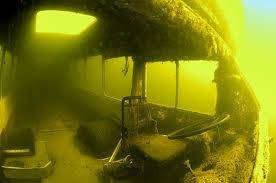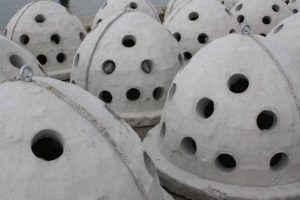Scuba diving at Artificial reefs
Ever done it before?! What is it? Where can you find them? Why is an artificial reef cool to scuba dive?
All kind of questions you may be wondering yourself. If you never done it during your scuba diving trip, I would say “go for it”!
Scuba diving at artificial reefs: What is it?
An artificial reef is a human made structure typically build to promote marine generally featureless bottom, to control erosion, block ship passage, or improve surfing (Wikipedia). Submerged shipwrecks are the most common form of artificial reefs. Other objects that also function as an artificial reef but were built for other purposes are objects like used oil rigs, bridges and other offshore structures. Although you can imagine that sinking an old oil rig is not really environmental friendly to say the least, some objects can be very interesting as an artificial reef if they prepare and strip them before sinking it!
Nowadays Marine resource managers create artificial reefs in underwater areas that require a structure to enhance the habitat for reef organisms, including corals to help the ecosystem. They use materials like PVC, concrete blocks, concrete structures and other metal structures. Lots can be said about artificial reefs and the construction of them. I want to leave that discussion to the conservation professionals. The reason for this blog is to point out a few interesting subjects about diving at artificial reefs and the difference in artificial reefs in the hope you find your own identity among the large amount of information about it.
Scuba diving at artificial reefs: Where can you find them
All around the world! Even in Holland! 😉 Not that most of you guys who read this blog think, “yeah, let’s go diving in Holland, brrrrrrr” But I would say: “why not?!” It’s beautiful and gives you a whole new set of scuba dive experience! In the so called “Vinkeveense plassen” between Amsterdam and Utrecht you find a whole underwater park with funny stuff, like objects from children playgrounds, an old city bus, little wrecks etc. If you are interested in scuba diving in Holland, Belgium and Germany visit this, you will be amazed about the diversity in dive spots (duikstekken) there.
Let’s have a look at a very special project about creating an artificial reef back in 2008. Photographer Stephen Mallon captured an amazing set of pictures over a period of years to document an interesting method that New York City developed to get rid of broken down subway cars in the Atlantic. After proper cleaning and stripping the cars down they were put on the ocean floor to create deep water artificial reefs. Over time they will be covered with all kinds of corals and attract fish to become their shelter place.
Using reef balls is a total other construction use of creating an artificial reefs. Reef balls are made of an eco friendly concrete to mimic natural reef systems. They are designed to create a habitat for fish and other marine species. They can be used to restore the coral reef after considerable damage done by dynamite fishing, a hurricane, over coastal development as in Hong Kong, unsustainable tourism or even a tsunami. What happens here is that there is a great loss of coral and most of the time the deeper reef is endangered due to the change of sand flow. The reef balls then will be placed in strategic locations to encourage new coral growth and provide shelter. You can dive with these everywhere in the world, but personally I would advice and check them out in Dubai or Thailand. More information check out the Coral Reef Alliance or google Reef ball Foundation.
Successful other artificial coral reef programs have been initiated in Bali, Komodo, Malaysia, Maldives and many other destinations worldwide. If you are interested in Marine conservation and you want to get more information about the importance of educating people have a look at this which is an example of a local marine conservation organization on a small island with 46 dive centers present.
Scuba dive at artificial reefs: Why is it cool?
First of all it’s fun and cool for your own scuba dive experience and education. Second of all and maybe even as important as the first, it’s all about environmental conservation. As a scuba diver you are aware of the importance of a healthy underwater environment for good diving. And the only place you want to spend your lovely diving holiday is at places with eccentric, cool diving. Why not combine the two and learn about the importance of protecting the underwater world and become involved in local and global conservation programs.
What we as Scuba Center Asia can do for you is keep informing you about different aspects concerning scuba diving at artificial reefs and environmental awareness. If you looking for some more thrill combined with artificial reef, have a look at our PADI Wreck Specialty. Important things you learn here are: safety considerations for navigating, mapping and exploring a wreck. Using special tools like penetration lines and reels to guide you through the wreck and expanding your scuba dive techniques to avoid kicking up silt or disturbing the wreck and its inhabitants. If you are looking for more educational environmental awareness we offer courses like AWARE Coral reef conservation, Peak Performance Buoyancy specialist or Project AWARE specialist.
In the end our mission is that whoever dives with Scuba Center Asia will find the enjoyment of exploring their own identity of scuba diving in a relaxed and pleasant way: an identity that suits you!









